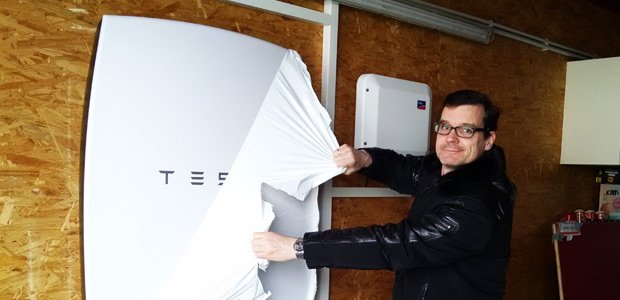Sun at Night: Sunny Boy Storage in the Field

Heinrich Eurich reports on his initial experiences with his PV storage system comprising the Sunny Boy Storage and Tesla Powerwall. As part of the field test for the Sunny Boy Storage, the SMA employee was one of the first to have the new storage system installed.
“Darn it, back payments again!” That’s how I always reacted when the annual electricity bill from the public utility company dropped into the mailbox. “Dad, we have enough power from the roof, why do we need to pay for more every year?” asked my son. “Because the sun doesn’t shine at night, it’s that simple,” I explained.
And somehow this very fact had always bugged me. Because my PV system actually generates too much electricity at 15.6 kW peak—just not always at the right time, unfortunately.
We need a lot of power in the evening especially, when our family of four comes back together after a working day: The TV, electric stove, electric kettle, computer, hot water heater and heating are our typical loads in the evening hours. Hot water? Heating? You got it. We don’t need gas or oil, we generate our energy carrier ourselves and “burn” it with an air-to-water heat pump.
So I was confronted with the issue of a “suitable storage system” since building our new home in 2011. Unfortunately, the implementation always fell at the hurdles of efficiency and space—we did not build a basement.
Next electricity bill eagerly awaited
And then the little, white Sunny Boy Storage and the slim, pretty battery arrived together.
The Tesla Powerwall was mounted flat on the wall, next to the little Sunny Boy Storage, with just a cable channel with the appropriate cables between, and the system was ready. A work of art for the garage. We have lost practically zero storage space in the garage, just as I always imagined it.
Conclusion after 40 days of operation from April to May:
Power purchased from the grid for about € 5/month; we can surely improve here. However, when compared with before, €100/month over the year, this is a great success.
Of course, the result will get worse in fall and winter, but when you think that we will achieve good average yields from early March to the end of September, there is a good chance that our electricity costs will fall by at least half. We are already looking forward to the next electricity bill.
“Now we must be able to afford a PlayStation,” said my boys. They’re always quick when it comes to such “initiatives.” I am more for a little family vacation, let’s see who wins.
Find more information on our product page.

Sounds good Heinrich, I like to see your configuration in Arizona (US) where we have triple digit heat for 5 months a year. Actually my 9kw does very well and I believe the Sunny boy storage and a Tesla Powerwall my just be the ticket